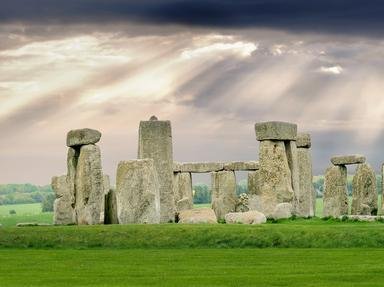Quiz Answer Key and Fun Facts
1. As you drive through the swirling mists of the Salisbury plain, the trailers of mist part and you gape incredulously at the glorious tableau. An ancient henge encloses enormous orthostats and colossal trilithons of heathen sarsen and shadowy dolerite. "Stonehenge..." you breathe in an awed whisper.
"Large rocks stuck in the sod," observes your more prosaic companion, "for no good reason that I can think of. Besides, technically, some would claim Stonehenge isn't even a henge, you know."
So, technically, what's a henge?
2. By the Middle Ages, the abandoned and mysterious stone formation in the sheep pastures of the Salisbury plain were known as "Stanenges". The two components of the name "Stonehenge" mean literally "stone hanging". It is not known for certain why the stone formation came to be given that name. The resemblance of monument stones to which of the following is the basis for one proposed explanation of the name?
3. You're taking a Stonehenge guided tour. You keep hearing technical terms, the meanings of which you are not entirely sure. You keep seeing big rocks. Which of the following means "big rock"?
4. Your Stonehenge guide points out the two varieties of stone present at the site. He mentions that an estimated eighty bluestones came from Wales, 250 miles away. The guide waxes eloquent about the difficulties involved in transporting and erecting the stone, seemingly unaware that Geoffrey of Monmouth's "History of the Kings of Britain", written in the early 12th century explained how it happened. What account did Geoffrey give?
5. Surprisingly, your Stonehenge guide mocks Geoffrey's account of the transport of the bluestones. "So, you think it was the Druids," you ask innocently. What role did Druids play in the construction of Stonehenge according to current archeological opinion?
6. Which of the following transport mechanisms have been proposed in modern times to account for the presence of stones from Wales in Stonehenge?
7. In 2001 experimental archaeologists attempted to duplicate the feat of transporting a large stone from Wales to Stonehenge utilizing methods and equipment that would have been available to the original builders. What is the most compelling reason to consider their experiment a failure?
8. As you tour Stonehenge, your guide draws you attention to white discs distributed around the periphery of the circle. He explains that the discs mark "Aubrey" holes. He mentions that according to the most accepted theory, these approximately three foot diameter holes (some of which have been found to contain human remains) were dug over 4000 years ago. What explanation does he give for the name of the holes?
9. "People screaming, black smoke towering out of burning caravans and everywhere there seemed to be people being bashed and flattened and pulled by the hair....men, women and children were led away, shivering, swearing, crying, bleeding..." Such was the description of the "Battle of the Beanfield", when a caravan traveling to celebrate the summer solstice at Stonehenge was turned back. In what year did the "Battle of the Beanfield" occur?
10. What would be the most foolproof method for having an opportunity to touch one of the stones while visiting Stonehenge?
Source: Author
uglybird
This quiz was reviewed by FunTrivia editor
Bruyere before going online.
Any errors found in FunTrivia content are routinely corrected through our feedback system.

